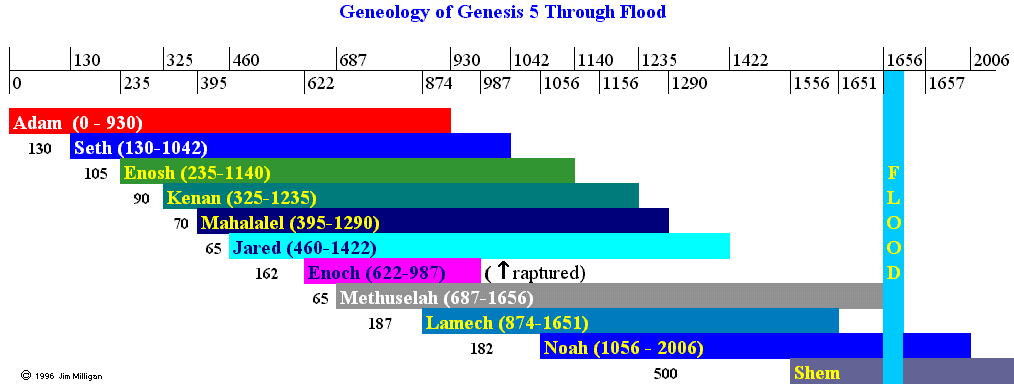Genesis Chapter Five
(Note: Genesis chapter five is a genealogy, which is a family history. Genealogies were important in this culture, and because of that importance, accuracy was imperative. The genealogies throughout the Bible line up, and this accuracy testifies to the accuracy of the Bible. Not all biblical genealogies list the firstborn, but they do list those through whom The Promise came.)
1. Review and compare what the Cainites were known for (4:17,22) versus what the Sethites were known for (4:26).
Cainites were shepherd people, city builders, tool makers. The Bible only lists worldly pursuits, no godly pursuits.
Sethites were people who “called on the name of the Lord.” They were godly. The Bible does not list any worldly pursuits. The Promise of Salvation would continue through the line of Seth.
2. Read Genesis 2:4 and Genesis 5:1. How does Moses organize the book of Genesis?
Moses uses the Hebrew word “toledothe” which means “to bear” and is translated as “generations.” (Different English translations of the Bible may use words such as “account,” “history,” or “genealogy” in place of “generations.”) Moses uses the word “toledothe” to distinguish different sections. Genesis 5:1 begins a new section detailing the descendants of Adam who shared his spirit, who were faithful, through whom the promise would descend, in contrast to the wickedness of Cain and his descendants.
3. How does one interpret the longevity of people in this genealogy?
It is to be interpreted literally. Notice the difference in lifespan before and after The Flood (see charts at end of entry).
There are a number of theories to account for the longevity of people at this time:
- The climate before the flood could have supported longer life; the size of animals in the fossil record certainly indicates a different climate capable of supporting unique animals.
- The human body, being so recently removed from its perfect state in the garden, and so close generationally to Adam and Eve, may have been less susceptible to degradation.
- Perhaps God simply made life longer for the first people to support the population of the earth.
- The Canopy Theory (The Creation Account describes God watering the earth through mist and by having water bubble up from the ground. Rain is not mentioned until The Flood. Some theorize that the cloud canopy was thicker before The Flood, blocking more harmful rays, allowing less damage on the human body. Once the first rain came in The Flood, the cloud canopy had thinned enough to allow more sun damage, thus lowering the lifespan of people.)
4. Could this genealogy be referring to clans?
Some speculate that the names in this genealogy are the names of clans rather than the names belonging to individuals. This theory does not makes sense. The statement of the age of each father when he begot a son does not allow for this theory. In addition, why would a listing of clans say a clan had “other sons and daughters”? These names belonging to clans rather than individuals would also mean that an entire clan named Enoch was raptured as opposed to the one man named Enoch. The language makes sense only when we assume these names refer to individuals rather than groups of people.
5. What is the significance of Genesis 5:3? (Seth was “in (Adam’s) own likeness, after (Adam’s) image.”)
God created man in His perfect image. Adam created man in imperfect image. We are still created in the image of God, but it is tainted by sinful nature.
6. What does it mean that Enoch “walked with God”?
A literal translation is appropriate here. We may presume that God still physically manifested himself upon the earth at this time, similar to His presence in the Garden. Take note of the preposition; elsewhere in scripture people walk before God, or after God, but only Enoch and Noah (Genesis 6:9) and the priests (Malachi 6:9) walk with God.
Enoch followed God’s will so closely that he was spared death. Enoch is one of two people in the Bible to be raptured.
Enoch was the seventh from Adam in Seth’s family. (Remember, seven is a significant number.) In contrast, Lamech was the seventh from Adam in Cain’s family. Lamech was an evil man who boasted about the murders he committed and started the first polygamous relationship.

Genealogy graph source: Lambert Dolphin’s Library

Life Span graph source: Christianity Stack Exchange
Note: My husband, DH, is teaching a weekly Bible study on the book of Genesis during his vicarage (internship). These are my notes from his classes. Questions, comments, and respectful debate are welcome.
DH has a B.A. in religious studies and biblical languages.
I have a B.A. in English, history, and Lutheran education.

